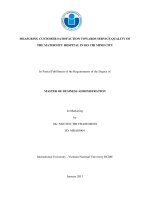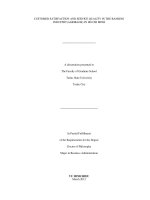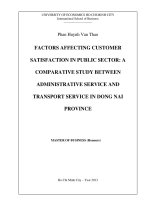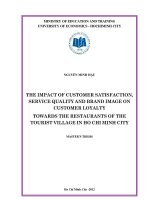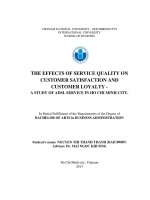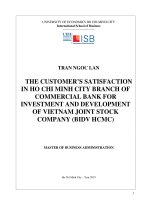The service quality factors affecting customer satisfaction in transfers and payments at asia commercial bank joint stock in ho chi minh city
Bạn đang xem bản rút gọn của tài liệu. Xem và tải ngay bản đầy đủ của tài liệu tại đây (2.41 MB, 109 trang )
MINISTRY OF EDUCATION AND TRAINING
THE STATE BANK OF VIETNAM
BANKING UNIVERSITY OF HO CHI MINH CITY
-----------------oo0oo----------------
LE HUY THONG
THE SERVICE QUALITY FACTORS AFFECTING CUSTOMER
SATISFACTION IN TRANSFERS AND PAYMENTS AT ASIA
COMMERCIAL BANK JOINT STOCK IN HO CHI MINH CITY
GRADUATION THESIS
BUSINESS ADMINISTRATION
MAJOR CODE: 7340101
SCIENCE INSTRUCTOR
PhD. BUI DUC SINH
HO CHI MINH CITY, 2021
MINISTRY OF EDUCATION AND TRAINING
THE STATE BANK OF VIETNAM
BANKING UNIVERSITY OF HO CHI MINH CITY
-----------------oo0oo----------------
LE HUY THONG
THE SERVICE QUALITY FACTORS AFFECTING CUSTOMER
SATISFACTION IN TRANSFERS AND PAYMENTS AT ASIA
COMMERCIAL BANK JOINT STOCK IN HO CHI MINH CITY
GRADUATION THESIS
BUSINESS ADMINISTRATION
MAJOR CODE: 7340101
SCIENCE INSTRUCTOR
PhD. BUI DUC SINH
HO CHI MINH CITY, 2021
ACKNOWLEDGEMENT
I would like to spend the most gorgeous words to teachers at Banking University, who
taught and gave me useful and valuable knowledge for my confidence to make this thesis.
Especially, sincere thanks to my science instructor – Ph.D. Bui Duc Sinh, for instructing
and heartlessly giving me to complete this. Although he is really busy with a lot of work,
he still receives and spends his time accompanying me throughout the course of this thesis.
Besides, he shows me about limitations and disadvantages I have to avoid to take the thesis
to a beautiful result.
I would also like to express my deep gratitude to the Board of Directors at Asia Commercial
Bank for creating opportunities for me in order to experience and study during my course.
Because of time limits, my thesis cannot avoid shortcomings. Thereby, I really look forward
to receiving the offerings from judges and readers to make my thesis more perfect.
Sincerely thank you!
II | P a g e
PLEDGE
The thesis with the topic “The service quality factors affecting customer
satisfaction in transfers and payments at Asia Commercial Bank Joint Stock in Ho Chi
Minh City” of the author’s research results. The research is truthful in which there is no
previously published content or content made by others except sufficient citations or source
citations in the thesis. The information and data used in the research processes are collected
by the author from various sources, which is completely truthful and clearly cited in the
references. The author is solely responsible for the content of his research.
Ho Chi Minh City, 22th June 2021
Author
Le Huy Thong
III | P a g e
ABSTRACT
The thesis with the topic “The service quality factors affecting customer satisfaction in
transfers and payments at Asia Commercial Bank Joint Stock in Ho Chi Minh City”
implemented to define the components affecting customer satisfaction and measure
impacted level on the factors with 277 samples which customers have been using service
at ACB in Ho Chi Minh city. The study uses both of methodologies (qualitative and
quantitative analysis). The qualitative analysis surveyed 30 random customers with a
particular time shows in the content part to undervest the clear in each sentence, content to
understanding the terms in the questionnaire. The quantitative research with 6 independent
observed variables correlates together and with a dependent variable (SAT). The collected
data used for evaluating the scale through Cronbach’s alpha, EFA, regression, correlation,
and so on in the research model. The thesis includes 3 main parts: First, the topic introduces
situations and makes the scale based on the model of Parasuraman (1985) named
SERVQUAL with some background in the service sector or refers to research buildings of
the author in Vietnam and abroad. Second, the result of variables in the research model
impacting on customer satisfaction at ACB in HCMC. Besides, the results after evaluating
the measurement such as Cronbach’s alpha, EFA, regression, correlation, and so on.
Finally, pointing out the limitations, administrative implications and resolves for the next
research directions. Thereby, bring it into ACB to operate in reality.
IV | P a g e
LIST OF ACRONYMS
ABBREVIATION
ORIGINAL
ACB
Asia Commercial Bank
SERVQUAL
The service quality model
REL
Reliability
RES
Responsiveness
AS
Assurance
TAN
Tangibles
EM
Empathy
PRI
Price
HCMC
Ho Chi Minh city
EFA
Exploratory Factor Analysis
ANOVA
Analysis Of Variance
PO
Payment order
JDI
Job decrective index
V|Page
LIST OF TABLE
Table 3.1. Research time plan. .................................................................................. ……19
Table 3.2. The Scale of reliability ...................................................................................... 26
Table 3.3. The Scale of responsiveness. ............................................................................. 26
Table 3.4. The Scale of assurance. ..................................................................................... 28
Table 3.5. The Scale of empathy. ....................................................................................... 28
Table 3.6. The Scale of tangible. ........................................................................................ 29
Table 3.7. The Scale of price. ............................................................................................. 29
Table 3.8 The final scale .................................................................................................... 31
Table 3.9 The data of quantitative research........................................................................ 34
Table 3.10 The scale of customer satisfaction with ACB's service. .................................. 39
Table 4.1: The descriptive statistical data of gender. ......................................................... 40
Table 4.2: Cronbach’s Alpha of the reliability scale. ......................................................... 42
Table 4.3: Cronbach’s Alpha of the responsiveness scale. ................................................ 43
Table 4.4: Cronbach’s Alpha of the assurance scale .......................................................... 44
Table 4.5: Cronbach’s Alpha of the empathy scale ............................................................ 44
Table 4.6: Cronbach’s Alpha of the tangible scale ............................................................ 45
Table 4.7: Cronbach’s Alpha of the price scale ................................................................. 45
Table 4.8: Item-total coefficient in satisfaction components ............................................. 46
Table 4.9: The Coefficient of general customer satisfaction.............................................. 47
Table 4.10: KMO and Bartlett’s test .................................................................................. 48
Table 4.11: Rotated Component Matrixa ............................................................................ 49
Table 4.13: Principal Component ....................................................................................... 51
Table 4.14: The correlation between the definitions .......................................................... 52
Table 4.15: Evaluate the suitable levels of multivariable regression model. ..................... 54
VI | P a g e
Table 4.16. T-Test analysis ................................................................................................ 54
Table 4.17: Evaluate the suitable for multivariables regression model. ............................ 56
Table 4.18: Multi-variable linear regression model. .......................................................... 57
Table 5.1. Factors impact on satisfaction. .......................................................................... 59
VII | P a g e
LIST OF FIGURE
Figure 2.1 - Positioning of literature on service charateristics ........................................ 7
Figure 2.2. ACB’s Payment order sample ....................................................................... 9
Figure 2.3. Payment in a bank ....................................................................................... 10
Figure 2.4. Payment in others ........................................................................................ 10
Figure 2.5. American Customer Sastifaction Index - ACSI .......................................... 13
Figure 2.6. Model of the relationship between sastifaction and quality ....................... 14
Figure 2.7. Resreaching of the relationship between customer satisfaction and service
quality in transferring payment in bank......................................................................... 17
Figure 3.1. Models of the procedures of the study ........................................................ 18
Figure 3.2. The theoretical model of customer satisfaction .......................................... 20
Figure 3.3. The procedure of analyzing the data ........................................................... 23
Figure 3.3 The procedure of analyzing the data ............................................................ 23
Figure 3.4 The affecting of the intermediate variable. .................................................. 24
Figure 3.5. Five - Gap Model ........................................................................................ 35
Figure 3.6 Five-dimensional quality model. ................................................................. 37
Figure 4.1: The descriptive statistical chart of age. ....................................................... 41
Figure 4.2: The descriptive statistics and the average of transactions. ......................... 41
VIII | P a g e
LIST OF APPENDIX
Appendix no.1: The survey table of qualitative…………………………………….67
Appendix no.2: The final table and satisfaction scale……………………………...70
Appendix no.3: The official scale…………………………………………………..73
Appendix no.4: Cronbach’s alpha…………………………………………………..77
Appendix no.5: EFA analysis……………………………………………………….81
Appendix no.6: Correlation and regression analysis………………………………..84
Appendix no.7: Levene’s analysis…………………………………………………..90
Appendix no.8: The chart of regression standardized residual……………………...91
Appendix no.9: The chart of observed cum prob…………………………………...92
Appendix no.10: The chart of regression standardized predicted value…………….93
TABLE OF CONTENT
PLEDGE .......................................................................................................................... III
ABSTRACT ..................................................................................................................... IV
LIST OF ACRONYMS ................................................................................................... IV
LIST OF TABLE ............................................................................................................. VI
LIST OF APPENDIX .........................................................................................................I
TABLE OF CONTENT ................................................................................................... II
CHAPTER I: INTRODUCTION ..................................................................................... 1
1.1.
The importance of research ................................................................................. 1
1.2.
Research question ................................................................................................. 2
1.3.
Scope of research. .................................................................................................. 3
1.3.1.
Research purpose. .......................................................................................... 3
1.3.2.
Objectives and scope of research. ................................................................. 3
1.4.
Methodology .......................................................................................................... 4
1.5.
Research significance ............................................................................................ 4
1.6.
Expected thesis structure/ Expected contribution ............................................. 5
CHAPTER II: LITERATURE REVIEW ....................................................................... 6
2.1. The definition of service .......................................................................................... 6
2.1.1 The definition of service ..................................................................................... 6
2.1.2 The characteristics of service. ............................................................................ 6
2.1.3 Service of Payment Order. ................................................................................. 9
Figure 2.4. Payment in others ................................................................................... 10
2.2. Service quality ....................................................................................................... 11
2.2.1. The definition of the service quality ............................................................... 11
2.2.1. The general awareness of service quality. ..................................................... 12
2.3. Customer’s satisfaction .......................................................................................... 12
2.4. The relationship between service quality and satisfied customer. .................... 13
2.5. Introduce SERVQUAL scale. ............................................................................... 14
2.6. Some researches of customers’ satisfaction with service quality....................... 15
2.7. Models of research and theories. .......................................................................... 16
CHAPTER III: ................................................................................................................. 18
RESEARCH METHODOLOGY ................................................................................... 18
3.1. The procedures of the study .................................................................................. 18
3.1.2. Qualitative analysis .......................................................................................... 19
3.1.3. Quantitative analysis ....................................................................................... 21
3.2. Official research. .................................................................................................... 25
3.2.3. Design questionable table. ............................................................................... 25
3.2.4. Constructing and adjusting the scale. ............................................................ 25
3.2.5. Implementation of quantitative research. ..................................................... 33
3.3.1. SERVQUAL scale - The service quality scale. .............................................. 35
3.3.2. The scale of the satisfied level. ........................................................................ 38
SUMMARY OF CHAPTER 3 ..................................................................................... 39
CHAPTER IV: ................................................................................................................. 40
DATA ANALYZE ........................................................................................................... 40
4.1. Statistical description. ............................................................................................ 40
4.1.1. Sample ............................................................................................................... 40
4.1.2. The information of the sample........................................................................ 40
4.2. Evaluate the reliability of the scale. ...................................................................... 42
4.2.1. Summary the conditions in reliable evaluation of the scale. ....................... 42
4.2.2. The scale of satisfied customer levels with transferring payments. ............ 46
4.2.3. The scale of generally satisfied customers. .................................................... 46
4.3. EFA – The discovering factors analysis. .............................................................. 48
4.3.1. Summary the conditions are to analyze EFA ................................................ 48
4.3.2. The result of analyzing factors. ...................................................................... 48
4.5. Correlation analysis ............................................................................................... 52
4.6. Regression analysis................................................................................................. 53
4.6.1. Test the hypothesis of regression model. ....................................................... 53
4.6.2. T-test ................................................................................................................. 54
4.6.3. ANOVA (option) .............................................................................................. 56
4.6.4. Evaluate the significance of each factor. ....................................................... 57
SUMMARY OF CHAPTER 4 ..................................................................................... 58
CHAPTER V: CONCLUSION AND MANAGERIAL IMPLICATIONS. ............... 59
5.1. The result and administrative implications. ........................................................ 59
5.2.1. Responsiveness ................................................................................................. 59
5.2.2. Assurance .......................................................................................................... 60
5.2.3. Reliability .......................................................................................................... 60
5.2.4. Tangible ............................................................................................................ 60
5.2.5. Price................................................................................................................... 61
5.3. Some limitations and the next research path. ..................................................... 61
SUMMARY OF CHAPTER 5 ..................................................................................... 62
CONCLUSION ................................................................................................................ 63
REFERENCE................................................................................................................... 64
APPENDIX No.1: THE SURVEY TABLE OF QUALITATIVE. .............................. 68
APPENDIX No.2: THE FINAL TABLE AND SATISFACTION SCALE................ 71
APPENDIX No.3: THE OFFICIAL SCALE ................................................................ 74
APPENDIX No.4: CRONBACH’S ALPHA ................................................................. 79
APPENDIX No.5: EFA analysis ..................................................................................... 83
APPENDIX No.6: CORRELATION and REGRESSION ANALYSIS ..................... 86
APPENDIX No.7: LEVENE’S ANALYSIS .................................................................. 92
APPENDIX No.8: THE CHART OF REGRESSION STANDARDIZED RESIDUAL
........................................................................................................................................... 93
APPENDIX No.9: THE CHART OF OBSERVED CUM PROB ............................... 94
APPENDIX
No.10:THE
CHART
OF
REGRESSION
STANDARDIZED
PREDICTED VALUE..................................................................................................... 95
CHAPTER I:
INTRODUCTION
1.1.
The importance of research
Service sector in general and in particular “Commercial banks” in Vietnam, that is always
wondering about: “How can they satisfy their customers? What factors will directly affect
the customer’s decision?” That’s the request which leaders are always put on top for the
company. Moreover, in order to survive in the business market, they have to constantly
change, improve, innovate their management methods and elevate their position day in and
day out to adapt to their customer while ensuring trust to customers.
The prequisition purpose of building this survey of customer satisfaction is that collecting
the values and reliability of reviews and perceptions from customer to business
performance. Besides, this activity helps to know what expectations do by customers? What
reasons related to that? After collecting pieces of information, then set up business strategy
and customer strategy. etc to allocate resources, improve weaknesses to serve the most
necessary customer's needs.
Many commercial banks are currently working on business activities in Vietnam that must
always compete in the diversity of many fields to develop the service sector and their
service quality and tackle all customer demands. ACB is no exception, however, the
similarity in terms of general fields at the commercial bank such as technology, brand,
service quality, etc is not yet popular. Therefore, in order to develop and survive
sustainably, they have to legalize supply and demand or in other called quantity goes
parallel with quality. Upgrading the company’s strongest points, creating its own distinctive
character identity.
Customers are the lifeblood of the bank, helping the bank to develop and survive through
transactions. Enhancing the service quality is the main factor of market competition,
commercial banks need to maintain, refer and constantly improve them through meeting
customer needs, which is the first step of optimization. Service quality is intangible,
affected by a service delivery banking process, from the beginning of the research model
1|Page
to the design of samples and customer care. The intangible nature of the services, taking
place in an indeterminate space and time, therefore, is assessed to be more difficult and
complex than goods or products.
Vietnam implemented its commitments when becoming an official member of the World
Trade Organization - WTO in the banking sector in November 2006. It was followed by
the participation of wholly foreign-owned banks and affiliated banks. Therefore, the fierce
competition among banking institutions in the future will become closer and closer, even
more fierce, this will be strongly implemented by Vietnam with its commitments set out
from the beginning.
After participating in WTO and facing many threats, opportunities, and even competitions,
national commercial banks are gradually enhancing their business competitiveness through
technology upgrading, network enhancement, increase in charter capital, etc to capture the
market before banks operate as the normal ways of the domestic banks. However, with
small-medium banks, it is necessary to speed up their operations to avoid the risk of
dissolution and merger due to improper regulations of the State Bank. For that main reason,
customer satisfaction is as well as a vital factor of success or failure.
Asia Commercial Joint Stock Bank – ACB is considered to be a banking institution that has
a scale of capital and human resources, moreover, the ACB system covers the whole
country from the north to the south. In the tendency of enhancing competition on customer
services quality, ACB is one of the competitors that understands and identifies clearly the
issues to serve the customer needs well and raise income from service activities parallelly.
In particular, the service, which ACB focuses on, improves the satisfaction of transferpayment service. That’s the reason why the author researches the topic: “The service
quality factors affecting customer satisfaction in transfers and payments at Asia
Commercial Bank Joint Stock in Ho Chi Minh City”.
1.2.
Research question
To make the purpose clearly in this research, the thesis needs to answer the research
questions below:
2|Page
Q1. What ACB’s strengths of transfer-payment service compare with other competitors in
the same field?
Q2. How will transfer-payment service quality affect customer satisfaction?
Q3. How will transfer-payment service quality affect ACB’s business performance?
1.3.
Scope of research.
1.3.1. Research purpose.
1.3.1.1. Overall purpose.
Assess market opportunities for development and diversification of customer segments
when applying the measures and proposals through the analysis of data and models from
research subjects. Since then, the bank will have reasonably guide innovations to elevate
the business performance and helps customers to satisfy working with ACB.
1.3.1.2. Detail purpose.
Seeking the current situations of commercial banks in Ho Chi Minh city. From there, apply
to Asia Commercial Bank to increase efficiency and increase satisfaction with services.
-
Identify the quality factors in bank transfer payment services at ACB.
-
Determining the impact of the service quality factors in wire transfer payments on
customer satisfaction.
-
Compare the differences of the factors of service quality between customers with
different characteristics such as age, gender, income, etc.
1.3.2. Objectives and scope of research.
1.3.2.1. Objectives.
Research topic about customers who have been using ACB’s main service is transfer and
payment in Ho Chi Minh City. The condition to participate in the thesis is the person who
has opened the account at ACB.
1.3.2.2. Scope of research.
The scope of research in ACB's transfer-payment service, business performance
development, and product situations. Due to limited time and budget, the topic is limited
within branches or transaction offices belongs to the East Saigon area.
3|Page
1.4.
Methodology
Using a combination of both methods, there are: quantitative and qualitative with some
others such as statistics, synthesis, analysis, and comparison to come up with a suitable plan
for service quality improvement.
This research goes through 2 phases:
-
Official research: Using quantitative method by the ways to interview directly with
the questionnaire table to determine models of scale and necessary factors affecting
the customer satisfaction when using transfer-payment service at ACB.
-
Data solving: Using SPSS ver.20.0 to review the scale, analyze Cronbach’s alpha,
EFA, regression model, etc.
Collecting the data from:
-
ACB web and department related.
-
Book, newspapers, journals of scientific research, and some web related..
1.5.
Research significance
The topic is a clear overview about determining all quality factors of transfer-payment
service in working ways of commercial banks in general. Since then, ACB can refer to this
thesis to promote and widen extra-extensions with customer satisfaction belongs to retail
fields or individuals, helping and improving the best of service performance to their
customers.
Also, they can:
-
Setting up all linked conditions for improving banking services.
-
Distributing to advance in competing and increase in revenue of service.
-
Helping improved service strategy planning and resource allocation and staff
capacity.
-
Basing on the results of situation assessment and solutions, ACB’s the board of
directors can observe clearly in impacted points, then changing and adjusting
reasonably.
4|Page
1.6.
Expected thesis structure/ Expected contribution
This thesis includes 5 chapters and 3 main chapters inside, exception introduce and
conclusion:
Chapter 1: Overview
Chapter 2: The theoretical overview.
Chapter 3: Research design
Chapter 4: Research result
Chapter 5: Conclusions and recommendations.
SUMMARY OF CHAPTER 1
Chapter 1 includes titles to make it clear in the theoretical basis of the thesis, shorten
some situations leading to topic construction. Finally, the author shows purposes and
hoping titles, scope, and survey objectives with methodologies related.
5|Page
CHAPTER II:
LITERATURE REVIEW
2.1. The definition of service
2.1.1 The definition of service
Until now, many service definitions have appeared, which many authors used and analyzed
in each of their views. So, accidentally that services are understood as:
“Service is a series of actions or activities which is intangible (no necessarily usually),
occurs correlation and connect customers with employees, between merchandises and
materials with solutions to solve all problem when customers meet, supplied by service
supplying system.” (Grönroos, 1990)
“Service is a transactional action, which is also invisible and without ownership, can
manufacturing or non-manufacturing goods” (Philip Kotler, 1997). In addition, service is
an economic activity where the source of consumption is not really a tangible product,
appearing in the process of using the product and developing product value in areas such
as health, beauty, etc. (V.A Zeithaml, L.L. Berry & A. Parasuraman, 1996).
In short, service is a series of actions that arise in transactions between parties A and B,
supplier and consumer, commodity and material, or more. That’s an idiosyncratic term in
terms of intangible, appearing the intending interaction together. Service also understood
by many definitions but the general purposes of service activities are to meet human
needs. Service is not merchandise but it serves directly all customer needs in society.
2.1.2 The characteristics of service.
According to service marketing as of 1980 shows results that services have four basic
characteristics: Intangible, Inseparability, Variability, and Perishability. Those form the
basis of service marketing and become an area different from product marketing. (Fisk, R.
P., Brown, S. W., & Bitner, M. J., 1993).
6|Page
Figure 2.1 - Positioning of literature on service charateristics
[Source: (Wolak, R., Kalafatis, S., & Harris, P, 1998)]
Refer to relevant documents, (Wolak, R., Kalafatis, S., & Harris, P, 1998) have established
the schematic as shown in figure 2.1. The reviews and comments showed two main work
contents that are the service characteristics do the key factors of the research? Figure 2.1
shows the ways to approach research until now, demonstrating theory more than reality.
(Hartman, D. E., & Lindgren, J. H, 1993) investigated how did consumers distinguish
between goods with services? This research is referred to as (Bowen, J, 1990) – Research
on service models without products and (Murray, K. B. and Schlacter, J.L, 1990) – How to
distinguish between goods with services by consumers.
2.1.2.1 Intangible
One of the four key properties, intangible is the primary service. “Actions, satisfaction, and
benefits are open to transact and perform in purchasing goods” were ideas proposed by
7|Page
(Regan, W. J, 1963). “Customers can easy to see the difference between service and product
through the meaning of tangible” (Darby, M. R., & Karni, E, 1973). (Onkvisit, S., & Shaw,
J. J, 1991) believe that service was born in manufacturing capacity, the intangible
characteristic is overrated while it is the manufacturing capacity that is the incentives, not
the tangible in incentives.
Service is a means, a term, or a definition that we are always mentioned by many people,
calling by name, but you can not touch by hand, hear by ears, smell by your nose prior to
taking it. You can only imagine service quality through activities, documents, price, and so
on as you usually see. With the intangible, business institutions always see the problem
when using the service for customers to comment and perceive. (Robinson, 1999)
2.1.2.2 Inseparability
The relationship between business and consumer will be formed from the concept of
service. Service only serves customer needs, so that is the reason why it is difficult for
businesses to adapt to customer needs. (Lâm Bảo Duy, 2016). This is difficult to manage
because it does not produce before selling out and thus lacks quality (Grönroos, 1990). That
is, it is difficult to make a clear in the period of production and use. Service and use happens
at the same time. It is different from the common product, which goes through many periods
prior to taking their products to consumers. (Svensson, G, 2002) insisted that services which
use a large workforce as the quality of service conversion are evident in the company that
provides the service, detailed in the correlation between customers and company members.
Some services have customer engagements that show opinions, which will help service
companies do fewer tasks than quality control because of customer impacts. In case,
customer comments are to be important.
2.1.2.3 Variability
The variability of service is always dependent on the business, suppliers, time, space, and
the methods of displaying supply services, which is reflected heavily in delivery service.
(Zeithaml, V. A., Parasuraman, A., & Berry, L. L;, 1985)
2.1.2.4 Perishability
As previously mentioned, service is non-storable, equivalent to commodity or tangible
products. Service is a simple thing to adjust based on each individual customer's needs
8|Page
(Rathmell, 1966). (Onkvisit, S., & Shaw, J. J, 1991) identified that service is perishable by
time. Failure issues depend on suppliers, only when consumers lack supplying sources and
wait for service that realizes that problems. (Hartman, D. E., & Lindgren, J. H, 1993)
2.1.3 Service of Payment Order.
2.1.3.1 The definition
PO(Payment order) is a bill, establishing from customer offers, who wants to extract some
money from their own account to receiver. PO only suitable when the customer agreed to
write, sign, and commit with the bank. After fulfilling the content of the PO and sending
the bank, PO will be accepted that transferring order, and then the bank will transfer it
immediately to the receiver.
PO is means that used incredibly flexible (bank-in or bank out), easy and convenient to
implement.
Figure 2.2. ACB’s Payment order sample
(Source: ACB’s Financial and Accountant deparment)
9|Page
2.1.3.2 The procedures of payout
Figure 2.3. Payment in a bank
(Source : Đàm Thị Thanh Hương, Voer newspaper)
a. The process of payment at the same bank includes:
1- Buyer send to the intermediary is the bank.
2- Seller send to the buyer.
3- Comercial bank sends debt notices to the buyer.
4- Banks send credit notes to recipients.
5Figure 2.4. Payment in others
(Source : Đàm Thị Thanh Hương, Voer newspaper)
10 | P a g e
b. The process of payment at other banks include:
1a - Seller send to the buyer.
1b- The payer gives 4 PO invoices to the commercial bank for them to pay to the
beneficiary.
2ab - The bank checks the buyer's invoice, account balance, if eligible, deduct the
payer's account, report the debt to them and transfer the money to the beneficiary's
bank for payment to the beneficiary.
3 - Upon receiving the payment order, the beneficiary's service bank will credit the
seller. If the beneficiary does not have a receiving account, the bank shall give credit
and contact the receiver to take the money directly to the bank.
2.1.3.3 Advantages and disadvantages of “Payment Order”.
Advantages:
- It is an easy, convenient, and easy-to-use form of payment.
- It is a kind of popular payment.
- Be active to pay with the buyer and hold the number of commodities when making
payouts.
Disadvantages:
- Extended debt arises when the buyer does not / has not paid
- Benefit of payment is not guaranteed due to no specific regulations, or incorrect
quality of goods.
2.2. Service quality
2.2.1. The definition of the service quality
Service quality is a factor that mentioning in business models and it is considered by
institutions to upgrade and update to compete with competitors. So, What’s service quality?
(Crosby, 1980) related to price in service; (Spreng, R. A., MacKenzie, S. B., & Olshavsky,
R. W, 1996) the satisfaction of customers with the number of customers who have used
services through business (Reichheld, F. F., & Sasser, W. E, 1990) and more detail in other
fields and banking sector. Service quality is the client's objective perception of a bank's
portfolio or transaction. When using the service cycle, service quality is formed between
11 | P a g e
